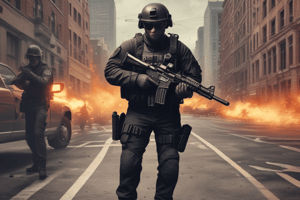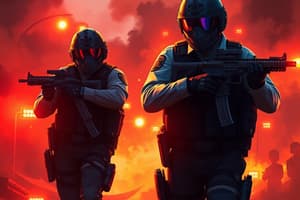Podcast
Questions and Answers
What is physical evidence?
What is physical evidence?
Any material that may aid in determining the truth during a crime investigation.
What are some types of evidence encountered in crime scenes?
What are some types of evidence encountered in crime scenes?
Prints, blood and body fluids, trace evidence, footwear impressions, tire impressions, weapons.
What is the value of physical evidence?
What is the value of physical evidence?
Can prove if a crime has been committed, establish identity, corroborate victim testimony, and more.
What are some preservation techniques for physical evidence?
What are some preservation techniques for physical evidence?
What is photographic documentation in crime scenes?
What is photographic documentation in crime scenes?
Which search pattern starts at the perimeter and works toward the center?
Which search pattern starts at the perimeter and works toward the center?
Which of the following is NOT a search pattern?
Which of the following is NOT a search pattern?
What should be documented when processing evidence on a victim or suspect?
What should be documented when processing evidence on a victim or suspect?
What are the basic steps for packaging and collecting evidence?
What are the basic steps for packaging and collecting evidence?
What is the chain of custody?
What is the chain of custody?
What is the importance of evidence integrity?
What is the importance of evidence integrity?
What is an active shooter?
What is an active shooter?
What is the difference between an active shooter and a hostage/barricaded suspect?
What is the difference between an active shooter and a hostage/barricaded suspect?
What are ways of preparing for an active shooter situation?
What are ways of preparing for an active shooter situation?
Identify initial deployment procedures when arriving on scene.
Identify initial deployment procedures when arriving on scene.
What are the tactics for contacting a suspect?
What are the tactics for contacting a suspect?
What is the survival mind-set?
What is the survival mind-set?
What are improvised explosive device (IED) procedures?
What are improvised explosive device (IED) procedures?
What is a barricaded suspect?
What is a barricaded suspect?
Define traditional deployment.
Define traditional deployment.
What is rapid deployment?
What is rapid deployment?
What is the timeline of violence?
What is the timeline of violence?
What is the #1 objective in responding to an active shooter?
What is the #1 objective in responding to an active shooter?
Describe the difference between traditional vs. nontraditional response.
Describe the difference between traditional vs. nontraditional response.
List the characteristics of culture.
List the characteristics of culture.
Explain the differences between prejudice, intolerance, and stereotypes.
Explain the differences between prejudice, intolerance, and stereotypes.
What are the elements of a law enforcement report?
What are the elements of a law enforcement report?
What are the components of a good report?
What are the components of a good report?
What are the steps of successful report writing?
What are the steps of successful report writing?
What is the importance of field notes?
What is the importance of field notes?
Define objective information.
Define objective information.
What are field notes?
What are field notes?
What are best practices while conducting a field interview?
What are best practices while conducting a field interview?
List methods of taking statements.
List methods of taking statements.
Identify the recommended order of progression for an initial interview.
Identify the recommended order of progression for an initial interview.
When should you mirandize?
When should you mirandize?
What percent of human communication is nonverbal?
What percent of human communication is nonverbal?
What is a physiological response?
What is a physiological response?
What three questions should you ask at the end of an interview known as the 'verbal lie detector'?
What three questions should you ask at the end of an interview known as the 'verbal lie detector'?
When interviewing, what percent should the interviewee be talking and the law enforcement officer?
When interviewing, what percent should the interviewee be talking and the law enforcement officer?
What is the purpose of the Omnibus Adult Protection Act?
What is the purpose of the Omnibus Adult Protection Act?
Identify the definitions listed in the Omnibus Adult Protection Act specific to abuse, caregiver, exploitation, facility, investigative entity, neglect, physical abuse, psychological abuse, and vulnerable adult.
Identify the definitions listed in the Omnibus Adult Protection Act specific to abuse, caregiver, exploitation, facility, investigative entity, neglect, physical abuse, psychological abuse, and vulnerable adult.
What are four dynamics of vulnerable adult victimization?
What are four dynamics of vulnerable adult victimization?
Identify the investigative and reporting requirements for law enforcement officers when responding to vulnerable adults.
Identify the investigative and reporting requirements for law enforcement officers when responding to vulnerable adults.
Explain how to properly apply emergency protective custody to vulnerable adults.
Explain how to properly apply emergency protective custody to vulnerable adults.
When should family court hold a probable cause hearing for protective custody?
When should family court hold a probable cause hearing for protective custody?
Is photographing visible trauma on an abused adult possible without consent?
Is photographing visible trauma on an abused adult possible without consent?
What should be stressed when approaching a vulnerable adult investigation?
What should be stressed when approaching a vulnerable adult investigation?
Is a bedsore a sign of abuse or neglect?
Is a bedsore a sign of abuse or neglect?
Identify common statistically supported situations involving legal issues, police lawsuits, assaults, and killings.
Identify common statistically supported situations involving legal issues, police lawsuits, assaults, and killings.
Identify specialized police equipment that can be used to mitigate officer injury.
Identify specialized police equipment that can be used to mitigate officer injury.
Identify the impact distance between the officer and their assailants that affects officers killed in the line of duty.
Identify the impact distance between the officer and their assailants that affects officers killed in the line of duty.
Identify reasons and causes of officer deaths nationwide.
Identify reasons and causes of officer deaths nationwide.
Identify responsibilities of the contact officer and cover officer.
Identify responsibilities of the contact officer and cover officer.
Identify types of officer ambushes and various countermeasures.
Identify types of officer ambushes and various countermeasures.
Identify deadly mistakes and tactical errors that decrease officer survivability.
Identify deadly mistakes and tactical errors that decrease officer survivability.
Identify proper countermeasures when attacked by an assailant with an edged weapon.
Identify proper countermeasures when attacked by an assailant with an edged weapon.
Identify how to respond to crimes while on-duty in plainclothes or off-duty.
Identify how to respond to crimes while on-duty in plainclothes or off-duty.
Identify proper considerations and tactics for engaging in an incident off-duty.
Identify proper considerations and tactics for engaging in an incident off-duty.
Identify the Golden Rule when confronted by uniformed officers when in plainclothes or armed off duty.
Identify the Golden Rule when confronted by uniformed officers when in plainclothes or armed off duty.
Four considerations for the selection and wearing of a ballistic vest are:
Four considerations for the selection and wearing of a ballistic vest are:
What is a qualified law enforcement officer?
What is a qualified law enforcement officer?
What is a qualified retired law enforcement officer?
What is a qualified retired law enforcement officer?
Identify South Carolina controlled substance statutes related to drug enforcement.
Identify South Carolina controlled substance statutes related to drug enforcement.
Identify common pharmaceutical and street-level drugs in terms of packaging, weights, paraphernalia, dangers, unusual odors.
Identify common pharmaceutical and street-level drugs in terms of packaging, weights, paraphernalia, dangers, unusual odors.
Identify basic tactics and techniques related to drug enforcement.
Identify basic tactics and techniques related to drug enforcement.
How far of a distance is it a separate offense to possess a sellable amount of a controlled substance from a school?
How far of a distance is it a separate offense to possess a sellable amount of a controlled substance from a school?
For a PWID, what do officers need to prove to charge suspects?
For a PWID, what do officers need to prove to charge suspects?
When an officer is investigating criminal activity or suspected criminal activity involving drugs, the officer should be?
When an officer is investigating criminal activity or suspected criminal activity involving drugs, the officer should be?
What is a narcotic?
What is a narcotic?
What is alcohol?
What is alcohol?
What is a field test kit?
What is a field test kit?
What is the NIK system?
What is the NIK system?
What are the most common reactions due to marijuana usage?
What are the most common reactions due to marijuana usage?
When you encounter a meth lab, what should you do?
When you encounter a meth lab, what should you do?
What should you do if you locate a meth lab or suspected meth lab?
What should you do if you locate a meth lab or suspected meth lab?
What are the techniques applicable to APC regarding potential crime scenes?
What are the techniques applicable to APC regarding potential crime scenes?
What are the types of crime scene locations commonly encountered?
What are the types of crime scene locations commonly encountered?
What are the legal issues that govern crime scene searches?
What are the legal issues that govern crime scene searches?
What are the duties of the first responder at a scene?
What are the duties of the first responder at a scene?
What is the definition of a crime scene?
What is the definition of a crime scene?
What is the definition of evidence and the types of evidence often encountered?
What is the definition of evidence and the types of evidence often encountered?
Flashcards are hidden until you start studying
Study Notes
Active Shooter Concepts
- An active shooter is an individual whose actions are immediately causing death and serious injury, creating a non-contained crisis with a high risk to victims.
- Difference between active shooter and hostage/barricaded suspect: Active shooter situations require rapid deployment to stop the threat, while hostage situations focus on containment and gathering information.
Preparation and Deployment
- Preparing for an active shooter involves understanding past incidents, noting pre-attack indicators, walking through potential locations, and maintaining readiness with proper equipment and mental preparedness.
- Initial deployment procedures include secretive and rapid approaches, ensuring officer safety before engaging with the suspect, and effective communication upon arrival at the scene.
Officer Movement and Tactics
- Efficient movement toward the threat is essential; utilize cover and maintain speed to achieve tactical advantages.
- Deployment strategies vary by the number of officers involved:
- Single officer must be prepared, while pairs can provide contact and cover roles.
- Larger groups should form diamond formations to cover wider areas effectively.
- Breaching techniques are necessary for entering secured areas, knowing how to handle various door types.
Interacting with Suspects
- Primary objective in contact with suspects is to neutralize threats effectively and maintain cover.
- Officers must have a survival mindset, which involves decisiveness, aggression, and mental flexibility in high-risk encounters.
- Improvised explosive device (IED) procedures call for a distancing tactic from the device while ensuring the shooter is still pursued.
Understanding Crime and Culture
- Hate crime defined as an offense motivated by bias against identifiable groups, affecting community relations and requiring sensitive handling by law enforcement officers.
- Cultural characteristics are learned behaviors that dictate acceptable societal norms and are constantly changing; no culture exists in complete isolation.
Report Writing Essentials
- An effective law enforcement report must be factual, clear, complete, concise, and in chronological order to ensure accurate documentation of incidents.
- Field notes serve as critical precursors to incident reports, aiding memory retention and the accuracy of details recorded.
- Procedures for documenting details involve the systematic gathering of information, including victim statements and scene examinations.
Interview Techniques
- Effective interviews involve a significant amount of talking from the interviewee (90% time), ensuring officers guide the discussion without interruption or bias.
- Noting physical and psychological reactions during interviews can signal deception; nonverbal cues like posture changes and vocal hesitations are key signs.
- Ending interviews with questions designed to probe the truth, such as "Did you do it?" helps clarify the resolution of the encounter.
Omnibus Adult Protection Act
- Provides a comprehensive approach to adult protection, establishing standardized definitions and duties for addressing issues like abuse and neglect of vulnerable adults.
- Definitions within the Act clarify terms such as abuse, caregiver, and exploitation, ensuring a coherent framework for legal enforcement and protective measures.### Definitions of Key Terms
- Exploitation: Involves forcing vulnerable adults into improper or unlawful activities against their wishes.
- Facility: Encompasses nursing care facilities, community residential care facilities, psychiatric hospitals, or any program operated by relevant health departments.
- Investigative Entity: Includes the Long-Term Care Ombudsman Program, Adult Protective Services, Vulnerable Adults Investigations Unit, and Medicaid Fraud Control Unit.
- Neglect: Failure of a caregiver to provide necessary care, leading to risks of physical or mental harm to a vulnerable adult.
- Physical Abuse: Intentional infliction of physical injury or allowing such injury to occur.
- Psychological Abuse: Deliberate intimidation, threats, or harassment causing emotional distress to vulnerable adults.
- Vulnerable Adult: An individual over 18 with physical or mental impairments that hinder self-care or protection.
Dynamics of Vulnerable Adult Victimization
- Caregiver Stress: Overwhelmed caregivers may neglect or abuse vulnerable adults.
- Perpetrator Characteristics: Certain traits or backgrounds increase the likelihood of abuse or neglect.
- Generational Violence: Patterns of violence may repeat across generations, impacting vulnerable adults.
- Self-Abuse/N neglect: Vulnerable adults may neglect their own needs, leading to worse outcomes.
Investigative and Reporting Requirements
- Law enforcement officers must report suspected abuse, neglect, or exploitation to appropriate entities and face penalties for failing to do so.
- Penalties for non-reporting include misdemeanor charges, fines up to $2,500, or imprisonment for up to one year.
Emergency Protective Custody
- Law enforcement can take vulnerable adults into protective custody without consent if imminent danger exists due to abuse, neglect, or exploitation.
- Immediate notification to Adult Protective Services and the Department of Social Services is required after custody.
Family Court Probable Cause Hearing
- A probable cause hearing for protective custody must be held within 72 hours.
Evidence Collection and Documentation
- Photographs of visible trauma can be taken without consent for vulnerable adults.
- Investigating authorities may request medical exams, and evidence must be documented meticulously for legal processes.
Officer Preparedness and Safety
- Maintaining a distance of 6-8 feet from suspects reduces the risk of injury.
- Deadly mistakes and tactical errors can decrease officer survivability, emphasizing the need for caution and communication.
- Specialized equipment like body armor significantly enhances officers' safety.
Drug Enforcement Strategies
- Arrests often require warrants and adherence to legal standards for searches.
- Field testing kits provide presumptive support but must be complemented with lab confirmation.
- Evidence must be collected and documented thoroughly to maintain integrity throughout the investigation process.
Crime Scene Management
- First responders must prioritize officer and public safety while preserving evidence.
- Proper documentation includes photographing scenes, following search patterns, and ensuring that the chain of custody is maintained.
- Evidence integrity is paramount for a reliable investigation outcome.
Engagement Considerations
- Maintain a survival mindset and be prepared for potential dangers when encountering crime scenes or vulnerable situations.
- Clear communication with family and teammates is essential for effective response and safety.
Studying That Suits You
Use AI to generate personalized quizzes and flashcards to suit your learning preferences.




